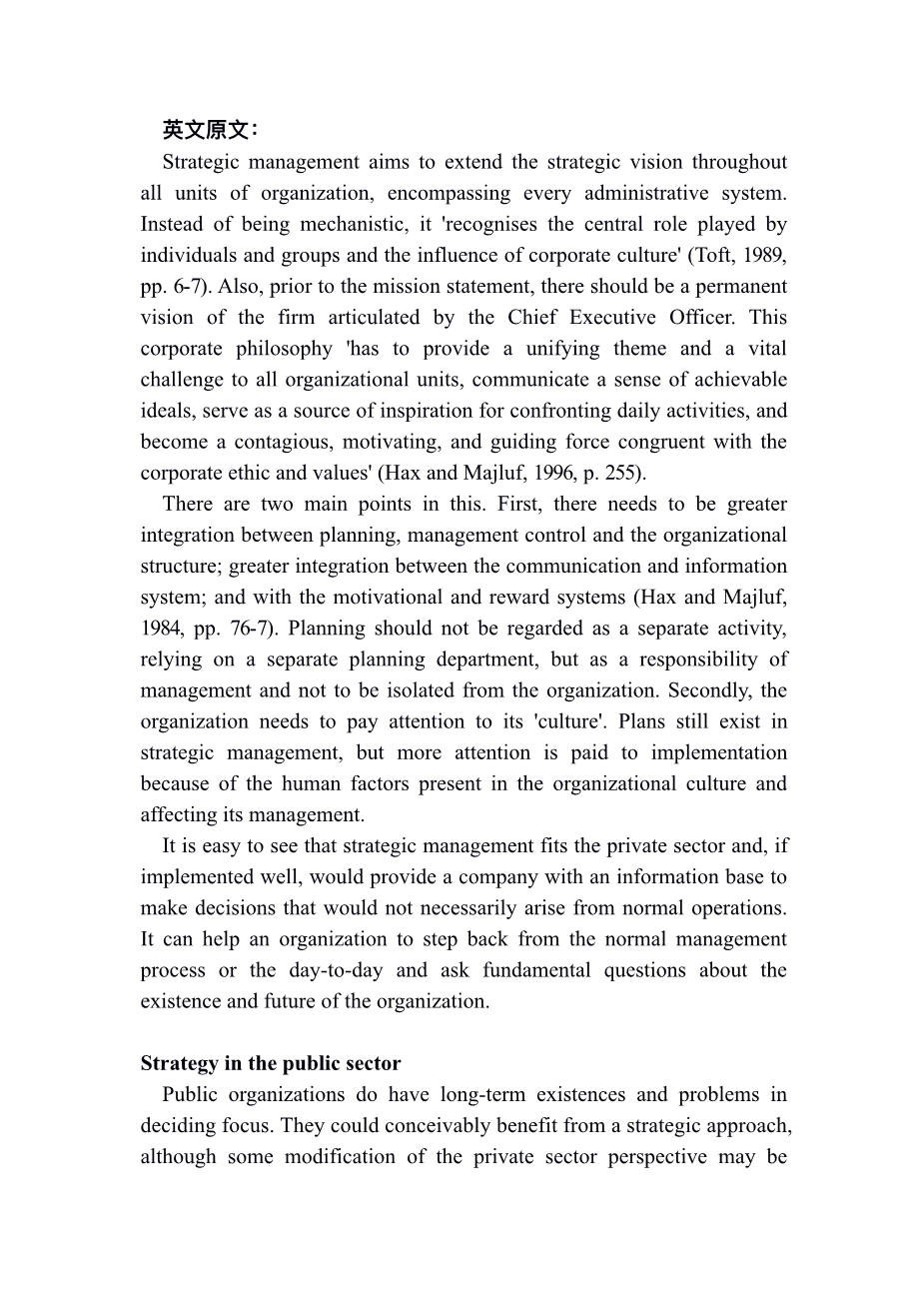Strategic management aims to extend the strategic vision throughout all units of organization, encompassing every administrative system. Instead of being mechanistic, it recognises the central role played by individuals and groups and the influence of corporate culture (Toft, 1989, pp. 6-7). Also, prior to the mission statement, there should be a permanent vision of the firm articulated by the Chief Executive Officer. This corporate philosophy has to provide a unifying theme and a vital challenge to all organizational units, communicate a sense of achievable ideals, serve as a source of inspiration for confronting daily activities, and become a contagious, motivating, and guiding force congruent with the corporate ethic and values (Hax and Majluf, 1996, p. 255).
There are two main points in this. First, there needs to be greater integration between planning, management control and the organizational structure; greater integration between the communication and information system; and with the motivational and reward systems (Hax and Majluf, 1984, pp. 76-7). Planning should not be regarded as a separate activity, relying on a separate planning department, but as a responsibility of management and not to be isolated from the organization. Secondly, the organization needs to pay attention to its culture. Plans still exist in strategic management, but more attention is paid to implementation because of the human factors present in the organizational culture and affecting its management.
It is easy to see that strategic management fits the private sector and, if implemented well, would provide a company with an information base to make decisions that would not necessarily arise from normal operations. It can help an organization to step back from the normal management process or the day-to-day and ask fundamental questions about the existence and future of the organization.
Strategy in the public sector
Public organizations do have long-term existences and problems in deciding focus. They could conceivably benefit from a strategic approach, although some modification of the private sector perspective may be necessary. There was always some kind of planning in the public sector and the methods used have fairly closely followed the five stages of planning set out earlier for the private sector. Budgeting and financial control started very early in the public sector. This planning stage could be argued to be the quintessence of organizations in the traditional model of administration, where the main planning aim is simply to spend the budget allocation. Long-range planning was also used in the same way as in the private sector and with the same problems of forecasting. Strategic planning in the public sector is a phenomenon of the early 1980s, significantly later than its development in the private sector. Strategic management was also adopted but, again, followed the private sector with a gap of some years. Since 1993 the United States federal government has established strategic planning as a universal requirement for its agencies (Joyce, 2000).
However, strategic planning and strategic management are private sector concepts and it cannot be taken for granted that the ideas will work in the public sector. There are more problems and constraints compared to the private sector and these range from constitutional arrangements to legislative and judicial mandates, to government-wide rules and regulations, to jurisdictional boundaries, to scarce resources, to political climate factors, to client and constituent interests (McCaffery, 1989, p. 207). Nutt and Backoff argue that strategic managers in the public sector should be wary of using private sector approaches that assume clear goals, profit or economic purposes, unlimited authority to act, secret development, limited responsibility for actions, and oversight through market mechanisms that signal financial results and in public organizations many of these assumptions are not valid (1992, p. 23). Early formulations of strategy in the public sector tended to commit all these sins, but the more recent movement towards strategic management may prove the most promising approach, as it has in the private sector.
Bozeman and Straussman argue there are three major features of a strategic approach: defining goals and objectives, developing an action plan that mediates between the organization and the environment, and designing effective methods of implementation (1990, p. 54). According to Allison, strategy involves establishing objectives and priorities for the organization (on the basis of forecasts of the external environment and the organizations capacities) and also devising operational plans to achieve these objectives.
Strategic planning models
In the same way as the private sector, the earliest stages of a strategic approach in the public sector were aimed at planning rather than management. A useful definition is that of Olsen and Eadie (1982, p. 4) in which strategic planning is a disciplined effort to produce fundamental decisions shaping the nature and direction of governmental activities, within constitutional bounds. This definition stresses three points. First, strategic decisions are fundamental decisions, not low-level ones, as the latter can presumably be performed by normal bureaucratic means. Secondly, strategic decisions are specified as decisions which affect the nature and direction of activities and the whole future of the organization. Thirdly, there are limits to the scope of strategic planning of a political and constitutional kind, which is an immediate difference from the private sector. Ideally, strategic planning does not subvert normal political or bureaucratic approaches but takes place within them.
In the early 1980s, Olsen and Eadie were among the pioneers who argued that strategic planning had a place in the public sector, which cou
剩余内容已隐藏,支付完成后下载完整资料


英语译文共 10 页,剩余内容已隐藏,支付完成后下载完整资料
资料编号:[254053],资料为PDF文档或Word文档,PDF文档可免费转换为Word


